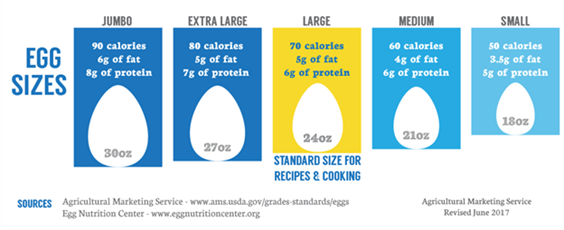by Tucker Diego, Agricultural Products Manager - June 2022
Do you sell eggs from your backyard poultry flock? Do you buy eggs at farmers' markets or grocery stores? Have you ever wondered what is required for grading and labeling chicken eggs? Whether you are producing or buying, here's the scoop...
All chicken eggs sold in Vermont must meet basic grade and labeling requirements. When consumers or poultry producers have questions about eggs, they can contact the Agricultural Products section through the Agency website. The Agency doesn’t normally perform egg quality inspections, but it does have authority over how eggs are labeled and sold and can send an Agricultural Products inspector to follow up on egg related complaints as they occur. Here are the basic requirements:
Size
Egg size is based on the minimum weight of a dozen eggs. The legal minimum weight for a dozen individual large eggs is 23 oz. (24 oz. with the carton). The graphic below from USDA shows the minimum weight of other common egg sizes along with the nutritional information.1

Grade
Each container of eggs sold at retail must be assigned a grade to indicate quality. The three commercial grades are AA, A, and B. Most eggs which are clean, unbroken, and fresh (i.e., packed within 30 days of laying) will meet grade A standards. Producers wishing to meet the AA standards should refer to USDA or Vermont grade specifications when inspecting their eggs to ensure they meet the higher standard.2 Grade B eggs allow for a greater percentage of eggs with checks (cracks) and a larger air gap (an indicator of freshness). Dirty eggs, leakers (eggs with cracks and damaged membrane), or eggs with other significant deficiencies are not approved for sale. Additional factors when assessing egg quality include shell shape and texture, the appearance of the yolk, and characteristics of the albumen (the egg white). Shell color is not a quality factor, but most eggs are separated by color to meet consumer preferences.
USDA Seal of Quality
Egg producers may choose to participate in USDA’s voluntary egg quality program which provides independent third-party verification that grade standards are being met and allows producers to label their eggs with a USDA shield logo. Eggs not produced under a USDA egg quality program, but which are sold in re-used cartons must have the USDA shield crossed out.

Fresh and clean
Vermont egg law does not specifically require producers wash their eggs; however, it does require that eggs and egg cartons are clean. Most large commercial egg producers wash eggs to meet consumer expectations and to prevent harmful pathogens from contaminating eggs. USDA guidelines recommend washing eggs with water at least 20 °F warmer than the internal temperature of the eggs and at a minimum of 90 °F. Eggs washed with cold water increases the chance for pathogens to be drawn through the shell and into the egg. USDA recommends drying eggs immediately after washing and always keeping eggs refrigerated to maintain quality.
Expiration, best-buy, and packing dates
Only grade AA or A eggs are allowed to be labeled as fresh. A common way producers track freshness is with a date printed on the carton. Expiration dates are commonly labeled as “EXP” or “Sell by” and indicate the date at which a product should no longer be sold. Expiration dates for eggs should not exceed 30 days from the packing date. “Best by” or “Use by” dates generally indicate the maximum time eggs are considered fresh. This terminology should not exceed 45 days from the packing date. Lastly, the packing date itself may be marked on cartons in the form of a lot code in the Julian calendar format (i.e., consecutive days of the year). The packing date can be used to estimate quality and for traceability purposes in the event of a recall.
For more information, contact Tucker.Diego@vermont.gov or by phone 802.622.4412.

Producer Name and Address
Many small-scale egg producers sell their eggs from the farm, at farmers' markets, or by other direct to consumer methods. Even the smallest egg producer should remember to include on their egg carton the producer’s name and address. If eggs are produced by a farm but packed or distributed by another business, then the label should accurately describe that relationship, such as by indicating “Produced for and distributed by ____” or “distributed by ____.” Additional labeling requirements can be found in the Vermont Weights and Measures Labeling guide.

